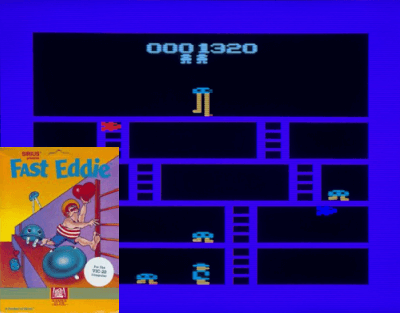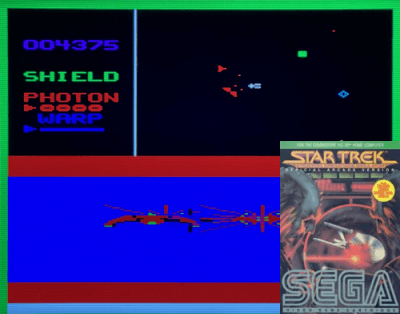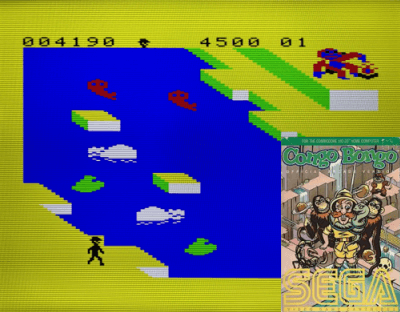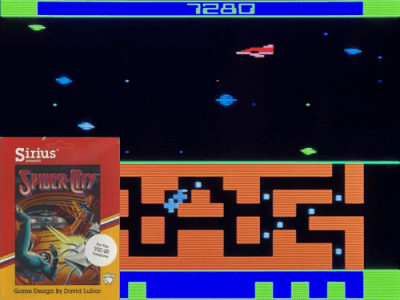Maybe it’s the holidays, but I was recently hit by a random streak of nostalgia around my family’s first ever computer, the Commodore VIC-20. I’m guessing it was sometime around 1985 or 1986 that my dad, almost certainly inspired by another family that we became friends with, the father being a huge Commodore 64 nerd, brought us home a VIC-20. We quickly amassed some game cartridges, a tape deck and a couple of tapes filled with demos and games, a joystick, and soon enough a Zenith ZVM-123 monochrome monitor so my brother and I weren’t tying up the family TV. I thought it would be fun to go back and revisit those first four cartridge-based games. This is where it all started for me!

“Fast Eddie plays exactly how you might imagine from this screen.”
Fast Eddie is a single screen side-perspective platformer similar to more well-known titles like Lode Runner, Jumpman, and Donkey Kong. Your objective is to avoid these little mushroom looking “Sneaker” dudes while you climb ladders up and down multiple levels collecting “prizes” that appear at random. There’s a really tall Sneaker on the top level (called the “High-Top”) who will shrink in height with each prize you collect, eventually getting short enough for Eddie to jump over, which completes the stage. It’s pretty simple, but even on the VIC-20 it feels reasonably fast and responsive. The challenge is in timing your movements with the fast moving Sneakers, which is easy to do, but the faster you try to clear a level, the more likely you are to make a mistake and lose a life. I also checked out the Commodore 64 version while I was at it, which despite being more colorful with higher resolution, well, everything, doesn’t have quite the same charm as the VIC-20 version to me. Still, the more responsive and smoother feeling controls make it the superior version.
Despite the fact that I recall liking Fast Eddie as a kid, it wasn’t my favorite, nor did it get a ton of playtime in my house. I think that’s likely because, like so many early arcade style games, the formula is almost immediately obvious and doesn’t deviate much from what is established at the start in anything but difficulty. Once you “figure it out” the only real drive to keep playing is to push yourself to further levels and higher scores. That said, it is fairly addictive, and when I replayed it for the first time in preparation for writing this article, I ended up playing it for a lot longer than originally planned. Not bad!

“Despite the clown car colors, killing Klingons is serious business.”
I never got into this next game as a kid, likely confused by its multiple perspectives and chaotic action, but I have fond memories of my brother camping out in front of this game for hours, filling little notepads up with diagrams and drawings. Having put a fair amount of time into the game while revisiting it for this post, I’m guessing these were simply sketches of ships and maybe a log of how far he made it and his scores, because an RPG or adventure game this is not; there’s really nothing to map nor clues to jot down.
Despite its title, Star Trek: Strategic Operations Simulator is purely an arcade action game, but one that crams a fair amount of ingenuity into its simple concept. On the top left of the screen you have indicators showing your health, photon torpedoes, and warp power. On the top right, you see an overhead view of your ship and the space around it in a style very similar to Asteroids. On the bottom of the screen, you see a first person perspective from the viewscreen of your ship (I assume the USS Enterprise?) which is synchronized with the action in the top down view. Pretty nifty. You fly around these little “sectors” shooting Klingon battlecruisers who are either attacking you, or focused on attacking your starbases. You can fly to a starbase to get a small bump in health, torpedoes, and warp. Your normal attack is an unlimited, rapid fire blast that is supposed to represent your ship’s phasers, but you can also launch a torpedo which has a devastating area of effect, and warping is simply a speed boost which I actually never found all that much use for. Once you dispatch all of the enemies, hopefully saving your starbases in the process, your score is tallied up and you move to the next sector map. There are some simple boss stages every 4 or 5 sectors as well. All in all, it didn’t really hook me, but it was fun, and I can imagine some people really enjoying it.
I tried out the Commodore 64 port of the game as well, and as with most games that exist on both platforms, while the gameplay is more or less identical, the graphics and sound are greatly improved (you can actually tell what the ships are supposed to be!) and control is a little more responsive, although it’s not bad in the VIC-20 port. The experience was so much more enjoyable that I ended up playing for quite awhile, far surpassing my previous high score on the VIC-20 version. Interestingly, the original game both of these ports are based on is a 1982 Sega arcade game. The arcade game looks vaguely familiar, but I don’t think I ever played growing up. Boasting impressive hi-res vector graphics and some digitized sound samples, it looks damn cool, although the gameplay is basically the same as what is presented in the home computer versions.

“Frogger with a weird perspective and terrible controls? Sign me up!”
Out of the four of these games, there’s only one I had almost zero recollection of and that’s because, well, we barely played it, and we barely played it because it fucking sucked. Congo Bongo is a platformer that plays like a sloppy combination of Donkey Kong, Pitfall!, and Frogger, depending on which level you play. That is, the first level has much more of a Donkey Kong vibe, while the second brings in those Frogger elements. The key difference is that the levels are shown from something of a skewed isometric perspective. Different enough to keep the lawyers away, I guess. The wacky perspective, terrible, jumpy animations which make dodging coconuts and hopping onto moving platforms feel excruciatingly inaccurate, and the less than responsive joystick controls made a game that probably already relied a bit too much on memorization just one big bum out. I ended up beating the first stage (a feat I don’t recall if I ever managed as a kid) after about a billion tries but, running out of patience, abused TheC64’s save states to get through the second. That was it though, that’s the game! In theory, those two levels repeat with a higher difficulty 4 more times, but there’s no way I was going to go any further, at least not with this version.
This game was ported all over the place, however, and morbidly curious, I decided to check out the very similar Commodore 64 version of the game. I’m happy to report that while it looks quite close, it has more colors, better sprites, better animations, slightly better sound, and vastly superior controls. The monkeys even properly harass you in this version! Still only two levels though. Interestingly, the Commodore 64 actually had a second port released a couple of years later in 1985 which had much nicer graphics sporting a much better take on the arcade version’s isometric perspective, all 4 levels from arcade, and a lot of other original elements intact. Unfortunately the cracked dump I played glitched out on the last level so I couldn’t legitimately beat it, but hey, not too shabby! In either case, I’d have been a lot more satisfied with the Commodore 64 versions of the game than I was with this awful VIC-20 one. Honestly, the best part was the awesome box with its colorful cartoony characters and massive Sega logo.
Oh, and yes, believe it or not this game was based on an arcade game. The arcade Congo Bongo actually had beautiful graphics for the time and, while I’m sure it was still a quarter sucking kick in the balls, the gameplay looks a lot smoother. As a kid I had no idea it was ever in the arcade, and I didn’t know until researching the game for this replay that there’s actually an interesting story behind the game being something of a troll of Nintendo over a lawsuit related to Donkey Kong. I’ve never seen that event referenced before, but I wonder if that’s where the Sega and Nintendo beef all started?

“Actually, Spider City doesn’t look half bad.”
My favorite of these games as a kid was Spider City, AKA Flash Gordon. Spider City was a side-scrolling shooter, likely influenced by the arcade classic Defender. On the top half of the screen is a view of your ship, and on the bottom a sort of mini-map showing you the tunnel system you’re navigating. The map was crucial for locating your objective, the hordes of hatching spider warriors you needed to murder. Of course, you also need to avoid debris, patrol ships, and other hazards, as well as rescue captured spacemen. I remember thinking the game looked good as a kid, but… eh? Still, of these four games it does the most with the VIC’s meager sound capabilities by a longshot.
In retrospect, dazzling graphics aside, I don’t know why it appealed to me quite so much back then, other than I remember wanting to ape my brother’s deep fascination with Star Trek: Strategic Operations Simulator by diving deep into and mastering a game of my own. That said, like Star Trek: SOS, there wasn’t actually all that much to master. Fly through the map avoiding and/or shooting everything on the screen (except for spacemen, which you could fly over to rescue) and seek out the hatching pods, mow down the hatching spiders which would hopefully grant your ship a temporary shield, then rinse and repeat until the entire map is clear. There were also these “disruptor” zones which moved around the map and would fill your screen with debris when you entered one, though you could shoot the generator inside of them to freeze them temporarily if you couldn’t simply avoid them. Of course, all of these details are fairly obtuse and unintuitive, and I’m mostly only able to talk about them clearly because I read the manual.
Unlike the rest of these games, Spider City didn’t have a Commodore 64 port. In fact, the only other place it appeared was the Atari 8-bit computers. Odd, given that it’s actually fairly fun.
These days I think I probably prefer Fast Eddie to Spider City, but I still have to give Spider City major credit for being the first video game I ever loved. Additional takeaways? While I’m endlessly grateful to my dad for bringing home my first ever personal computer, I mean, I have multiple hobbies and a career to thank for my interest in computers, I definitely wish it was a Commodore 64 instead of a VIC-20. Oh well. As an aside, I’d love to make a part two to this if I can ever figure out exactly what those cassette tapes I mentioned having were. I have no idea if they were commercial releases or otherwise widely distributed, or if some dude at whatever local computer shop my dad got this stuff from cobbled them together himself. A mystery for another day. *shrug*
Apologies for the poor quality pictures – there are some major color inaccuracies, for instance. These were photos from my TV (usually at night, even) rather than actual screenshots. Box art stolen from LaunchBox’s games database.